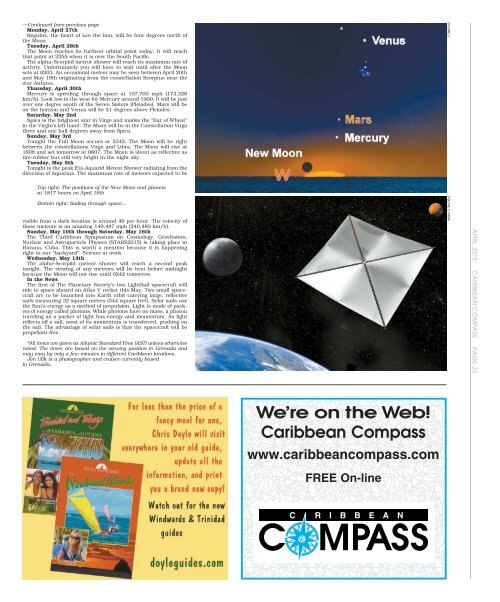Caribbean Compass Yachting Magazine April 2015
Welcome to Caribbean Compass, the most widely-read boating publication in the Caribbean! THE MOST NEWS YOU CAN USE - feature articles on cruising destinations, regattas, environment, events...
Welcome to Caribbean Compass, the most widely-read boating publication in the Caribbean! THE MOST NEWS YOU CAN USE - feature articles on cruising destinations, regattas, environment, events...
You also want an ePaper? Increase the reach of your titles
YUMPU automatically turns print PDFs into web optimized ePapers that Google loves.
— Continued from previous page<br />
Monday, <strong>April</strong> 27th<br />
Regulus, the heart of Leo the lion, will be four degrees north of<br />
the Moon.<br />
Tuesday, <strong>April</strong> 28th<br />
The Moon reaches its furthest orbital point today. It will reach<br />
that point at 2355 when it is over the South Pacific.<br />
The alpha–Scorpiid meteor shower will reach its maximum rate of<br />
activity. Unfortunately you will have to wait until after the Moon<br />
sets at 0203. An occasional meteor may be seen between <strong>April</strong> 20th<br />
and May 19th originating from the constellation Scorpius near the<br />
star Antares.<br />
Thursday, <strong>April</strong> 30th<br />
Mercury is speeding through space at 107,700 mph (173,326<br />
km/h). Look low in the west for Mercury around 1900. It will be just<br />
over one degree south of the Seven Sisters (Pleiades). Mars will be<br />
on the horizon and Venus will be 21 degrees above Pleiades.<br />
Saturday, May 2nd<br />
Spica is the brightest star in Virgo and marks the “Ear of Wheat”<br />
in the Virgin’s left hand. The Moon will be in the Constellation Virgo<br />
three and one half degrees away from Spica.<br />
Sunday, May 3rd<br />
Tonight the Full Moon occurs at 2342. The Moon will be right<br />
between the constellations Virgo and Libra. The Moon will rise at<br />
1808 and set tomorrow at 0607. The Moon is about as reflective as<br />
tire-rubber but still very bright in the night sky.<br />
Tuesday, May 5th<br />
Tonight is the peak Eta-Aquarid Meteor Shower radiating from the<br />
direction of Aquarius. The maximum rate of meteors expected to be<br />
Top right: The positions of the New Moon and planets<br />
at 1817 hours on <strong>April</strong> 18th<br />
Bottom right: Sailing through space…<br />
visible from a dark location is around 40 per hour. The velocity of<br />
these meteors is an amazing 149,487 mph (240,480 km/h).<br />
Sunday, May 10th through Saturday, May 16th<br />
The Third <strong>Caribbean</strong> Symposium on Cosmology, Gravitation,<br />
Nuclear and Astroparticle Physics (STARS<strong>2015</strong>) is taking place in<br />
Havana, Cuba. This is worth a mention because it is happening<br />
right in our “backyard”. Science at work.<br />
Wednesday, May 13th<br />
The alpha–Scorpiid meteor shower will reach a second peak<br />
tonight. The viewing of any meteors will be best before midnight<br />
because the Moon will not rise until 0242 tomorrow.<br />
In the News<br />
The first of The Planetary Society’s two LightSail spacecraft will<br />
ride to space aboard an Atlas V rocket this May. Two small spacecraft<br />
are to be launched into Earth orbit carrying large, reflective<br />
sails measuring 32 square metres (344 square feet). Solar sails use<br />
the Sun’s energy as a method of propulsion. Light is made of packets<br />
of energy called photons. While photons have no mass, a photon<br />
traveling as a packet of light has energy and momentum. As light<br />
reflects off a sail, most of its momentum is transferred, pushing on<br />
the sail. The advantage of solar sails is that the spacecraft will be<br />
propellant-free.<br />
*All times are given as Atlantic Standard Time (AST) unless otherwise<br />
noted. The times are based on the viewing position in Grenada and<br />
may vary by only a few minutes in different <strong>Caribbean</strong> locations.<br />
Jim Ulik is a photographer and cruiser currently based<br />
in Grenada.<br />
FIGURE 2 FIGURE 3 NASA<br />
APRIL <strong>2015</strong> CARIBBEAN COMPASS PAGE 33<br />
We’re on the Web!<br />
<strong>Caribbean</strong> <strong>Compass</strong><br />
www.caribbeancompass.com<br />
FREE On-line


















